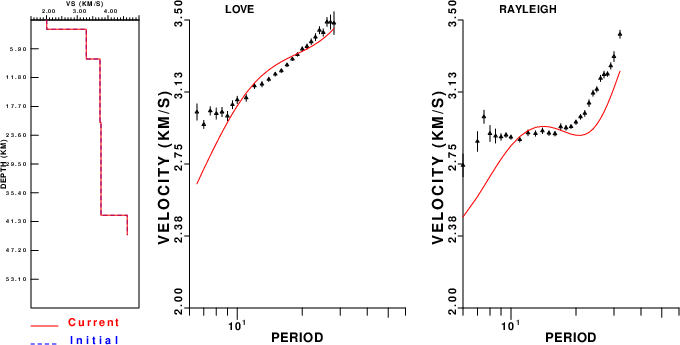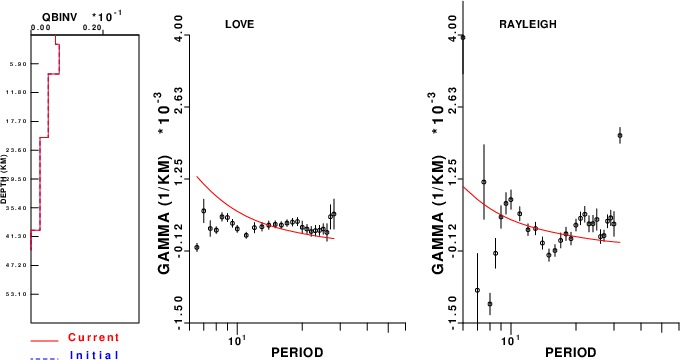Location
Location ANSS
The ANSS event ID is nn00247350 and the event page is at
https://earthquake.usgs.gov/earthquakes/eventpage/nn00247350/executive.
2008/05/08 05:55:02 39.540 -119.926 2.6 3.6 Nevada
Focal Mechanism
USGS/SLU Moment Tensor Solution
ENS 2008/05/08 05:55:02:0 39.54 -119.93 2.6 3.6 Nevada
Stations used:
BK.CMB BK.HUMO BK.MOD BK.ORV BK.WDC BK.YBH CI.MLAC CI.TIN
IM.NV31 NN.BEK TA.N10A TA.Q10A TA.S10A US.ELK US.WVOR
XQ.ME09 XQ.ME10 XQ.ME11 XQ.ME13 XQ.ME17 XQ.ME18 XQ.ME20
XQ.ME25 XQ.ME26 XQ.ME29 XQ.ME59 XQ.ME60 XQ.ME62 XQ.ME80
XQ.ME81 XQ.ME82 XQ.ME83 XQ.ME84 XQ.ME85 XQ.ME86 XQ.ME87
XQ.ME88 XQ.ME90 XQ.ME92 XQ.ME93
Filtering commands used:
cut o DIST/3.3 -40 o DIST/3.3 +50
rtr
taper w 0.1
hp c 0.03 n 3
lp c 0.07 n 3
Best Fitting Double Couple
Mo = 3.27e+21 dyne-cm
Mw = 3.61
Z = 8 km
Plane Strike Dip Rake
NP1 300 90 -160
NP2 210 70 0
Principal Axes:
Axis Value Plunge Azimuth
T 3.27e+21 14 73
N 0.00e+00 70 300
P -3.27e+21 14 167
Moment Tensor: (dyne-cm)
Component Value
Mxx -2.66e+21
Mxy 1.54e+21
Mxz 9.70e+20
Myy 2.66e+21
Myz 5.60e+20
Mzz 0.00e+00
--------------
---------------------#
---------------------#######
-------------------###########
--------------------##############
-------------------#################
#####-------------####################
#########---------################## #
############-----################### T #
################-#################### ##
################---#######################
###############--------###################
##############------------################
############----------------############
###########--------------------#########
##########-----------------------#####
########----------------------------
#######---------------------------
#####-------------------------
####------------- --------
#------------- P -----
---------- -
Global CMT Convention Moment Tensor:
R T P
0.00e+00 9.70e+20 -5.60e+20
9.70e+20 -2.66e+21 -1.54e+21
-5.60e+20 -1.54e+21 2.66e+21
Details of the solution is found at
http://www.eas.slu.edu/eqc/eqc_mt/MECH.NA/20080508055502/index.html
|
Preferred Solution
The preferred solution from an analysis of the surface-wave spectral amplitude radiation pattern, waveform inversion or first motion observations is
STK = 210
DIP = 70
RAKE = 0
MW = 3.61
HS = 8.0
The NDK file is 20080508055502.ndk
The waveform inversion is preferred.
Moment Tensor Comparison
The following compares this source inversion to those provided by others. The purpose is to look for major differences and also to note slight differences that might be inherent to the processing procedure. For completeness the USGS/SLU solution is repeated from above.
| SLU |
UCB |
USGS/SLU Moment Tensor Solution
ENS 2008/05/08 05:55:02:0 39.54 -119.93 2.6 3.6 Nevada
Stations used:
BK.CMB BK.HUMO BK.MOD BK.ORV BK.WDC BK.YBH CI.MLAC CI.TIN
IM.NV31 NN.BEK TA.N10A TA.Q10A TA.S10A US.ELK US.WVOR
XQ.ME09 XQ.ME10 XQ.ME11 XQ.ME13 XQ.ME17 XQ.ME18 XQ.ME20
XQ.ME25 XQ.ME26 XQ.ME29 XQ.ME59 XQ.ME60 XQ.ME62 XQ.ME80
XQ.ME81 XQ.ME82 XQ.ME83 XQ.ME84 XQ.ME85 XQ.ME86 XQ.ME87
XQ.ME88 XQ.ME90 XQ.ME92 XQ.ME93
Filtering commands used:
cut o DIST/3.3 -40 o DIST/3.3 +50
rtr
taper w 0.1
hp c 0.03 n 3
lp c 0.07 n 3
Best Fitting Double Couple
Mo = 3.27e+21 dyne-cm
Mw = 3.61
Z = 8 km
Plane Strike Dip Rake
NP1 300 90 -160
NP2 210 70 0
Principal Axes:
Axis Value Plunge Azimuth
T 3.27e+21 14 73
N 0.00e+00 70 300
P -3.27e+21 14 167
Moment Tensor: (dyne-cm)
Component Value
Mxx -2.66e+21
Mxy 1.54e+21
Mxz 9.70e+20
Myy 2.66e+21
Myz 5.60e+20
Mzz 0.00e+00
--------------
---------------------#
---------------------#######
-------------------###########
--------------------##############
-------------------#################
#####-------------####################
#########---------################## #
############-----################### T #
################-#################### ##
################---#######################
###############--------###################
##############------------################
############----------------############
###########--------------------#########
##########-----------------------#####
########----------------------------
#######---------------------------
#####-------------------------
####------------- --------
#------------- P -----
---------- -
Global CMT Convention Moment Tensor:
R T P
0.00e+00 9.70e+20 -5.60e+20
9.70e+20 -2.66e+21 -1.54e+21
-5.60e+20 -1.54e+21 2.66e+21
Details of the solution is found at
http://www.eas.slu.edu/eqc/eqc_mt/MECH.NA/20080508055502/index.html
|
This is a preliminary NCSS moment tensor solution for the event located
5 km NE of Verdi-Mogul, NV; 39.5415N 119.9168W; Z=2.5km; ML=3.54;
(USGS/UCB Joint Notification System) on 05/08/2008 05:55:01:760 UTC.
Other information about this event can be viewed at:
RECEIVED Thu, 8 May 2008 17:52:28 -0500 (CDT)
Reviewed by:
Peggy
UCB Seismological Laboratory
Inversion method: complete waveform
Stations used: NN.BEK BK.ORV BK.CMB BK.HELL
Berkeley Moment Tensor Solution
Best Fitting Double-Couple:
Mo = 3.40E+21 Dyne-cm
Mw = 3.62
Z = 5 km
Plane Strike Rake Dip
NP1 118 -167 82
NP2 26 -8 77
Event Date/Time: 05/08/2008 05:55:01:760
Event ID: 51202333
-----------
-----------------------
------ --------------------##
--------- P -------------------######
----------- -------------------########
-----------------------------------##########
-----------------------------------############
------------------------------------#############
-------------------------------------################
##-----------------------------------##################
#####--------------------------------##################
########-----------------------------####################
############-------------------------######################
###############----------------------######################
##################------------------#######################
#####################--------------########################
#########################----------##########################
###########################------##########################
###############################-###########################
###############################---#########################
# ##########################--------#####################
T #########################--------------###############
########################-------------------##########
#########################-------------------------#####
#######################------------------------------
####################-----------------------------
#################------------------------------
###############------------------------------
############-----------------------------
########-----------------------------
###----------------------------
-----------------------
-----------
Lower Hemisphere Equiangle Projection
Deviatoric Solution:
Principal Axes:
Axis Value Plunge Azimuth
T 3.227 3 252
N 0.288 75 149
P -3.516 14 343
Source Composition:
Type Percent
DC 83.6
CLVD 16.4
Iso 0.0
Moment Tensor: Scale = 10**21 Dyne-cm
Component Value
Mxx -2.707
Mxy 1.847
Mxz -0.925
Myy 2.640
Myz 0.099
Mzz 0.066
-----------
-----------------------
------- -------------------##
---------- P -------------------#####
------------ -------------------#######
-----------------------------------##########
------------------------------------###########
------------------------------------#############
-------------------------------------################
##------------------------------------#################
####---------------------------------##################
########-----------------------------####################
############-------------------------######################
###############---------------------#######################
###################---------------#########################
#######################---------###########################
#############################################################
###########################################################
###########################################################
###########################################################
# #######################################################
T ##############################-----###################
##########################----------------###########
##########################-------------------------####
########################-----------------------------
####################-----------------------------
#################------------------------------
###############------------------------------
###########------------------------------
#######------------------------------
##-----------------------------
-----------------------
-----------
Lower Hemisphere Equiangle Projection
|
Magnitudes
Given the availability of digital waveforms for determination of the moment tensor, this section documents the added processing leading to mLg, if appropriate to the region, and ML by application of the respective IASPEI formulae. As a research study, the linear distance term of the IASPEI formula
for ML is adjusted to remove a linear distance trend in residuals to give a regionally defined ML. The defined ML uses horizontal component recordings, but the same procedure is applied to the vertical components since there may be some interest in vertical component ground motions. Residual plots versus distance may indicate interesting features of ground motion scaling in some distance ranges. A residual plot of the regionalized magnitude is given as a function of distance and azimuth, since data sets may transcend different wave propagation provinces.
ML Magnitude

Left: ML computed using the IASPEI formula for Horizontal components. Center: ML residuals computed using a modified IASPEI formula that accounts for path specific attenuation; the values used for the trimmed mean are indicated. The ML relation used for each figure is given at the bottom of each plot.
Right: Residuals from new relation as a function of distance and azimuth.

Left: ML computed using the IASPEI formula for Vertical components (research). Center: ML residuals computed using a modified IASPEI formula that accounts for path specific attenuation; the values used for the trimmed mean are indicated. The ML relation used for each figure is given at the bottom of each plot.
Right: Residuals from new relation as a function of distance and azimuth.
Context
The left panel of the next figure presents the focal mechanism for this earthquake (red) in the context of other nearby events (blue) in the SLU Moment Tensor Catalog. The right panel shows the inferred direction of maximum compressive stress and the type of faulting (green is strike-slip, red is normal, blue is thrust; oblique is shown by a combination of colors). Thus context plot is useful for assessing the appropriateness of the moment tensor of this event.
Waveform Inversion using wvfgrd96
The focal mechanism was determined using broadband seismic waveforms. The location of the event (star) and the
stations used for (red) the waveform inversion are shown in the next figure.

|
|
Location of broadband stations used for waveform inversion
|
The program wvfgrd96 was used with good traces observed at short distance to determine the focal mechanism, depth and seismic moment. This technique requires a high quality signal and well determined velocity model for the Green's functions. To the extent that these are the quality data, this type of mechanism should be preferred over the radiation pattern technique which requires the separate step of defining the pressure and tension quadrants and the correct strike.
The observed and predicted traces are filtered using the following gsac commands:
cut o DIST/3.3 -40 o DIST/3.3 +50
rtr
taper w 0.1
hp c 0.03 n 3
lp c 0.07 n 3
The results of this grid search are as follow:
DEPTH STK DIP RAKE MW FIT
WVFGRD96 1.0 200 55 -15 3.33 0.4096
WVFGRD96 2.0 205 65 -10 3.43 0.5194
WVFGRD96 3.0 210 70 5 3.46 0.5694
WVFGRD96 4.0 205 70 -15 3.50 0.6003
WVFGRD96 5.0 210 75 0 3.52 0.6201
WVFGRD96 6.0 210 75 0 3.54 0.6325
WVFGRD96 7.0 210 75 -5 3.57 0.6413
WVFGRD96 8.0 210 70 0 3.61 0.6464
WVFGRD96 9.0 210 80 15 3.63 0.6441
WVFGRD96 10.0 210 80 15 3.64 0.6401
WVFGRD96 11.0 210 80 15 3.66 0.6332
WVFGRD96 12.0 210 80 15 3.68 0.6242
WVFGRD96 13.0 210 80 15 3.69 0.6129
WVFGRD96 14.0 210 80 15 3.70 0.5997
WVFGRD96 15.0 210 75 10 3.71 0.5867
WVFGRD96 16.0 210 75 10 3.72 0.5724
WVFGRD96 17.0 210 75 10 3.73 0.5577
WVFGRD96 18.0 210 75 10 3.74 0.5426
WVFGRD96 19.0 210 75 10 3.75 0.5277
WVFGRD96 20.0 210 75 10 3.76 0.5134
WVFGRD96 21.0 210 75 10 3.76 0.4990
WVFGRD96 22.0 210 75 15 3.77 0.4852
WVFGRD96 23.0 210 80 15 3.77 0.4723
WVFGRD96 24.0 210 80 15 3.78 0.4601
WVFGRD96 25.0 210 80 10 3.79 0.4481
WVFGRD96 26.0 210 80 10 3.79 0.4369
WVFGRD96 27.0 210 80 10 3.79 0.4262
WVFGRD96 28.0 210 80 10 3.80 0.4165
WVFGRD96 29.0 210 80 10 3.80 0.4073
The best solution is
WVFGRD96 8.0 210 70 0 3.61 0.6464
The mechanism corresponding to the best fit is

|
|
Figure 1. Waveform inversion focal mechanism
|
The best fit as a function of depth is given in the following figure:

|
|
Figure 2. Depth sensitivity for waveform mechanism
|
The comparison of the observed and predicted waveforms is given in the next figure. The red traces are the observed and the blue are the predicted.
Each observed-predicted component is plotted to the same scale and peak amplitudes are indicated by the numbers to the left of each trace. A pair of numbers is given in black at the right of each predicted traces. The upper number it the time shift required for maximum correlation between the observed and predicted traces. This time shift is required because the synthetics are not computed at exactly the same distance as the observed, the velocity model used in the predictions may not be perfect and the epicentral parameters may be be off.
A positive time shift indicates that the prediction is too fast and should be delayed to match the observed trace (shift to the right in this figure). A negative value indicates that the prediction is too slow. The lower number gives the percentage of variance reduction to characterize the individual goodness of fit (100% indicates a perfect fit).
The bandpass filter used in the processing and for the display was
cut o DIST/3.3 -40 o DIST/3.3 +50
rtr
taper w 0.1
hp c 0.03 n 3
lp c 0.07 n 3

|
|
Figure 3. Waveform comparison for selected depth. Red: observed; Blue - predicted. The time shift with respect to the model prediction is indicated. The percent of fit is also indicated. The time scale is relative to the first trace sample.
|

|
|
Focal mechanism sensitivity at the preferred depth. The red color indicates a very good fit to the waveforms.
Each solution is plotted as a vector at a given value of strike and dip with the angle of the vector representing the rake angle, measured, with respect to the upward vertical (N) in the figure.
|
A check on the assumed source location is possible by looking at the time shifts between the observed and predicted traces. The time shifts for waveform matching arise for several reasons:
- The origin time and epicentral distance are incorrect
- The velocity model used for the inversion is incorrect
- The velocity model used to define the P-arrival time is not the
same as the velocity model used for the waveform inversion
(assuming that the initial trace alignment is based on the
P arrival time)
Assuming only a mislocation, the time shifts are fit to a functional form:
Time_shift = A + B cos Azimuth + C Sin Azimuth
The time shifts for this inversion lead to the next figure:

The derived shift in origin time and epicentral coordinates are given at the bottom of the figure.
Surface-Wave Focal Mechanism
The following figure shows the stations used in the grid search for the best focal mechanism to fit the surface-wave spectral amplitudes of the Love and Rayleigh waves.
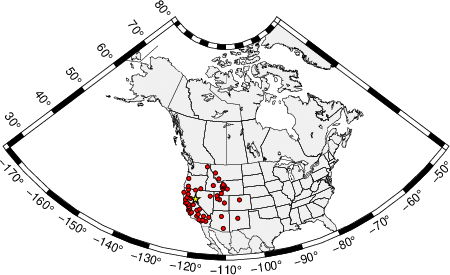
|
|
Location of broadband stations used to obtain focal mechanism from surface-wave spectral amplitudes
|
The surface-wave determined focal mechanism is shown here.
NODAL PLANES
STK= 21.87
DIP= 68.52
RAKE= -32.50
OR
STK= 124.99
DIP= 60.00
RAKE= -154.99
DEPTH = 4.0 km
Mw = 3.63
Best Fit 0.8812 - P-T axis plot gives solutions with FIT greater than FIT90
Surface-wave analysis
Surface wave analysis was performed using codes from
Computer Programs in Seismology, specifically the
multiple filter analysis program do_mft and the surface-wave
radiation pattern search program srfgrd96.
Data preparation
Digital data were collected, instrument response removed and traces converted
to Z, R an T components. Multiple filter analysis was applied to the Z and T traces to obtain the Rayleigh- and Love-wave spectral amplitudes, respectively.
These were input to the search program which examined all depths between 1 and 25 km
and all possible mechanisms.
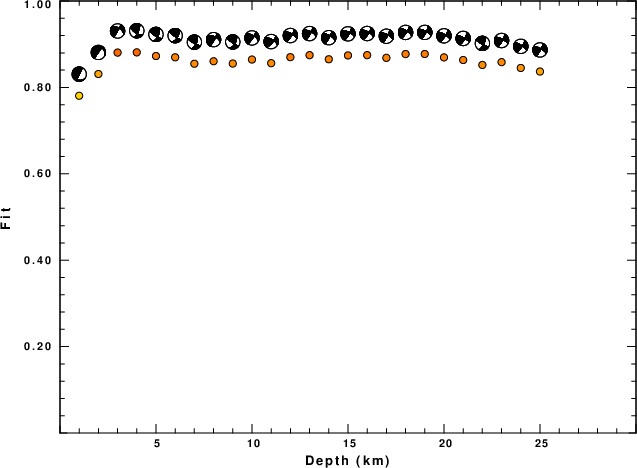
|
|
Best mechanism fit as a function of depth. The preferred depth is given above. Lower hemisphere projection
|
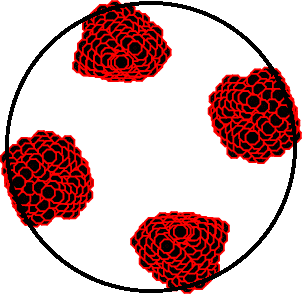
|
|
Pressure-tension axis trends. Since the surface-wave spectra search does not distinguish between P and T axes and since there is a 180 ambiguity in strike, all possible P and T axes are plotted. First motion data and waveforms will be used to select the preferred mechanism. The purpose of this plot is to provide an idea of the
possible range of solutions. The P and T-axes for all mechanisms with goodness of fit greater than 0.9 FITMAX (above) are plotted here.
|
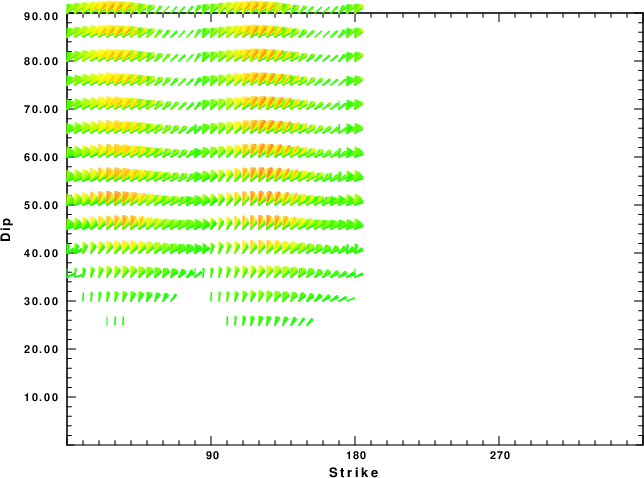
|
|
Focal mechanism sensitivity at the preferred depth. The red color indicates a very good fit to the Love and Rayleigh wave radiation patterns.
Each solution is plotted as a vector at a given value of strike and dip with the angle of the vector representing the rake angle, measured, with respect to the upward vertical (N) in the figure. Because of the symmetry of the spectral amplitude rediation patterns, only strikes from 0-180 degrees are sampled.
|
Love-wave radiation patterns
Rayleigh-wave radiation patterns














